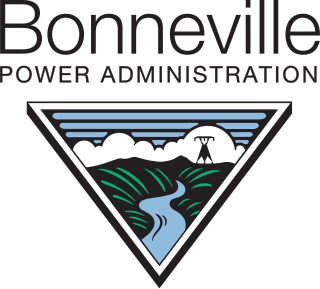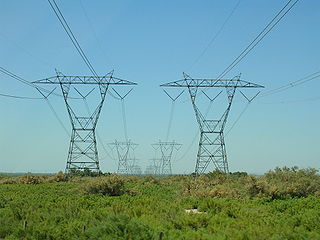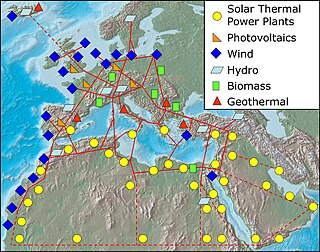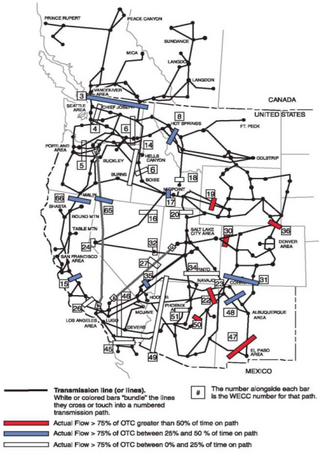
The Bonneville Power Administration (BPA) is an American federal agency operating in the Pacific Northwest. BPA was created by an act of Congress in 1937 to market electric power from the Bonneville Dam located on the Columbia River and to construct facilities necessary to transmit that power. Congress has since designated Bonneville to be the marketing agent for power from all of the federally owned hydroelectric projects in the Pacific Northwest. Bonneville is one of four regional Federal power marketing agencies within the U.S. Department of Energy (DOE).

The Pacific DC Intertie is an electric power transmission line that transmits electricity from the Pacific Northwest to the Los Angeles area using high voltage direct current (HVDC). The line capacity is 3.1 gigawatts, which is enough to serve two to three million Los Angeles households and represents almost half of the Los Angeles Department of Water and Power (LADWP) electrical system's peak capacity.

Path 27, also called the Intermountain or the Southern Transmission System (STS), is a high-voltage direct current (HVDC) electrical transmission line running from the coal-fired Intermountain Power Plant near Delta, Utah, to the Adelanto Converter Station at Adelanto, California, in the Southwestern United States. It was installed by Asea, a company based in Sweden, and commercialized in July 1986. The system is designed to carry power generated at the power plant in Utah to areas throughout Southern California. It is owned and operated by the Intermountain Power Agency, a cooperative consisting of six Los Angeles-area cities, the largest member being the Los Angeles Department of Water and Power (LADWP), and 29 smaller Utah municipalities.
The East–West Interconnector is a 500 MW high-voltage direct current submarine and subsoil power cable from 2012 which connects the Irish and British electricity markets, between Dublin and the Wales/England border. The project was developed by the Irish national grid operator EirGrid.

Path 15 is an 84-mile (135 km) portion of the north–south power transmission corridor in California, U.S. It forms a part of the Pacific AC Intertie and the California-Oregon Transmission Project. Path 15 is part of The Western Electricity Coordinating Council's links of electrical intertie paths in the western United States.

Path 26 is a set of three Southern California Edison (SCE) 500 kV power lines, located primarily in Los Angeles County, and extending into Kern and Ventura counties, all in California. Path 26 is part of the Western Electricity Coordinating Council's links of electrical intertie paths in the western United States. The Path 26 lines are located in: the San Joaquin Valley of the southern Central Valley; the Tehachapi Mountains and other central Transverse Ranges; and the Antelope Valley section of the Mojave Desert.

Path 62 or the Eldorado - McCullough 500 kV Line is a short 0.6 mi (1 km) 500 kV power line linking Los Angeles Department of Water and Power's (LADWP's) McCullough substation to Southern California Edison's (SCE's) Eldorado substation in the Eldorado - Marketplace - McCullough substation complex just south of Boulder City, Nevada. Path 62 is part of The Western Electricity Coordinating Council's links of electrical intertie paths in the western United States. Like Path 61, this short, yet important 500 kV line allows for power flow to be rerouted on different 500 kV lines that make up the massive Path 46 transmission system when necessary. Power generated from Hoover Dam, and fossil fuel power plants in the Four Corners region is routed to this substation complex via many other 500 kV lines that connect to this substation complex.
Path 46, also called West of Colorado River, Arizona-California West-of-the-River Path (WOR), is a set of fourteen high voltage alternating-current transmission lines that are located in southeast California and Nevada up to the Colorado River.

A super grid or supergrid is a wide-area transmission network, generally trans-continental or multinational, that is intended to make possible the trade of high volumes of electricity across great distances. It is sometimes also referred to as a "mega grid". Super grids typically are proposed to use high-voltage direct current (HVDC) to transmit electricity long distances. The latest generation of HVDC power lines can transmit energy with losses of only 1.6% per 1,000 km.

Wyoming has one of the highest wind power potentials of any state in the United States. In 2019, Wyoming had wind powered electricity generating capacity of 1,589 MW, which produced 9.85% of its electric generation, with an additional 3,753 MW under construction. However, the wind generation in that year was Wyoming's third-lowest in the 2010s. By 2020, wind capacity increased to 2738 MW and 8448 gigawatt-hours of electricity were produced from wind in 2021, more than double 2019 production. Additional wind capacity and needed transmission lines are under construction or planned, despite political headwinds from Wyoming's strong coal and oil sectors.

The Trans Bay Cable is a high-voltage direct current (HVDC) underwater transmission cable interconnection between San Francisco, California and Pittsburg, California. The 53 mi (85 km) cable under San Francisco Bay and through the Carquinez Strait can transmit 400 megawatts of power at a DC voltage of ±200 kV, enough to provide 40% of San Francisco's peak power needs.
The Mead substation is a major electric power interconnection point in the western United States. The station is located in the El Dorado Valley of Nevada just outside of Boulder City, at the end of Buchanan Boulevard south of its grade separation with Interstate 11. The facility is owned and operated by the Western Area Power Administration.

The Western Electricity Coordinating Council (WECC) coordinates a number of high voltage power links in western North America. These links, known as WECC Intertie Paths, are not necessarily single transmission line, rather they are interties between various areas. These areas can be quite distant, such as Path 65 between The Dalles, Oregon and Los Angeles, California or short such as Path 62 between Southern California Edison's Eldorado and LADWP's McCullough substations. These are currently numbered from 1 to 81, with a few numbers intentionally omitted.
One Nevada is a 235-mile (378 km), 500-kilovolt, 600-megawatt power line that runs from Southern to Northern Nevada. NV Energy owns 25% of the transmission line and operates and offers the line's capacity under the terms of NV Energy's Open Access Transmission Tariff. Great Basin Transmission South owns 75% of the line. The line runs from the new Robinson Summit Substation in Ely to Apex, connecting with the existing NV Energy Harry Allen Generating Station, and uses tubular guyed-V towers on a single point foundation.
The Marketplace substation is a major electric power interconnection point in the western United States outside of Boulder City, Nevada. The station is in the Eldorado Valley.
The Chokecherry and Sierra Madre Wind Energy Project is large-scale wind farm currently under construction near Rawlins, Wyoming. If completed as scheduled in 2026, it will likely become the largest wind farm in the United States and one of the largest in the world. Located largely on federal lands, the project is being built in conjunction with the TransWest Express transmission line to supply power to California. Originally slated for completion in 2020, the finish date was extended to 2026 in 2019 amid permitting, environmental, and construction delays.
Adelanto Converter Station in Adelanto, California, is the southern terminus of the 2,400 MW Path 27 Utah–California high voltage DC power (HVDC) transmission line. The station contains redundant thyristor-based HVDC converters rated for 1,200 MW continuous or 1,600 MW short term overload. The 300-acre (120 ha) station was completed in July, 1986 at a cost of US$131 million. The northern terminus of Path 27 is fossil fueled Intermountain Power Plant in Utah.

The Juan de Fuca Cable Project is a proposed 550 MW, 150 kV high-voltage direct current (HVDC) submarine power cable connection running 19 miles (31 km) under the Strait of Juan de Fuca between Port Angeles, Washington, and Victoria, British Columbia. The project's final environmental impact statement was completed in October 2007, and a presidential permit issued in June 2008.
LS Power is an American independent power company that owns, operates, and develops power generating stations, storage facilities, and transmission lines. Founded in 1990, the company originally focused on developing and selling natural gas power plants, but has since expanded into developing renewable energy plants and transmission lines. The company's approach focuses on competing to win transmission line contracts at a lower price than established utilities and using its large asset portfolio to develop projects with "high barriers to entry." With a combined capacity of 2.3 GW of pumped storage hydropower and lithium-ion battery storage, LS Power has the largest non-utility owned energy storage portfolio in the United States.










